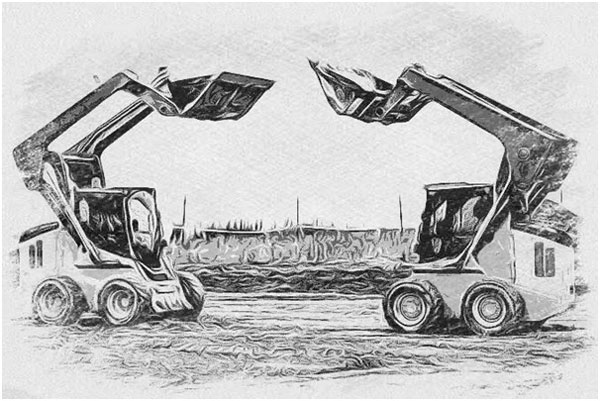Skid-steer loaders are typically four-wheel vehicles with the wheels mechanically locked in synchronization on each side, and where the left-side drive wheels can be driven independently of the right-side drive wheels. A skid loader can be described as a small, rigid-frame machine with lift arms used to attach a wide variety of labor-saving tools or attachments.
The wheels of the skid steer loader typically have no separate steering mechanism and hold a fixed straight alignment on the body of the machine. Turning is accomplished by differential steering, in which the left and right wheel pairs are operated at different speeds, and the machine turns by skidding or dragging its fixed-orientation wheels across the ground. Skid-steer loaders are sometimes equipped with tracks instead of the wheels, and such a vehicle is known as a multi-terrain loader or more simply as a track loader.
Attachments of skid steer loaders
The conventional bucket of many skid loaders can be replaced with a variety of specialized buckets or attachments, many powered by the loader’s hydraulic system. These include- backhoe, hydraulic breaker, pallet forks, angle broom, sweeper, auger, mower, snow blower, stump grinder, tree spade, trencher, dumping hopper, pavement miller, ripper, tillers, grapple, tilt, roller, snow blade, wheel saw, cement mixer, and wood chipper machine.
Some models of skid steer now also have an automatic attachment changer mechanism. This allows a driver to change between a variety of terrain handling, shaping, and leveling tools without having to leave the machine, by using a hydraulic control mechanism to latch onto the attachments. Hydraulic supply lines to powered attachments may be routed so that the couplings are located near the cab, and the driver does not need to leave the machine to connect or disconnect those supply lines.

Advantages of skid steer loader
The skid steer loader is a very versatile machine with the capability to perform different kinds of construction tasks. It can be either on tracks or on wheels. The features of this machine are incredibly useful. Many construction projects include skid steer loaders because they provide many benefits. Some of its advantages are given below.
- The size and weight
- Attachments And Flow Rate
- Visibility And Control
- Ease of use
- Easy access
- Portable
- Easy to maintain
- Added Safety Features
- Optimal Visibility & Control
- Operator comfort
- Great maneuverability

Applications of skid steer loader
A skid-steer loader is one of the most versatile pieces of construction equipment. Using different attachments, a skid-steer loader can perform a range of tasks, from excavation and grading to demolition and debris removal to overhead work and lifting.
A skid-steer loader can sometimes be used in place of a large excavator by digging a hole from the inside. The skid loader first digs a ramp leading to the edge of the desired excavation. It then uses the ramp to carry material out of the hole. The skid loader reshapes the ramp making it steeper and longer as the excavation deepens. This method is particularly useful for digging under a structure where overhead clearance does not allow for the boom of a large excavator, such as digging a basement under an existing house. Several companies make backhoe attachments for skid-steers. These are more effective for digging in a small area than the method above and can work in the same environments. Other applications may consist of transporting raw material around a job site, or assisting in the rough grading process.
A small skid-steer loader is most able to maneuver in tight spaces and drive through narrow passageways, making it the best choice for interior work. Small loaders are the most common size used for landscaping, site development, and final grading and to add soil layers over patios, sidewalks and other areas.
A medium-size skid-steer loader can be used in many other areas where a small loader is not suitable to complete the work. For example, this machine can be used when there is no room for large backhoes or excavators and where a digger is not allowed.
A medium-size skid-steer loader can be used in many other areas where a small loader is not suitable to complete the work. For example, this machine can be used when there is no room for large backhoes or excavators and where a digger is not allowed.
Conclusion
Relentless transformations in infrastructure frameworks and a burgeoning engineering and construction industry are likely to increase the demand for skid steer loaders. The manufacturers are carrying out various technological enhancements through improvisations in a few key aggregates to enhance fuel efficiency and increase the productivity of skid steer loaders thus helping them deliver even higher output

